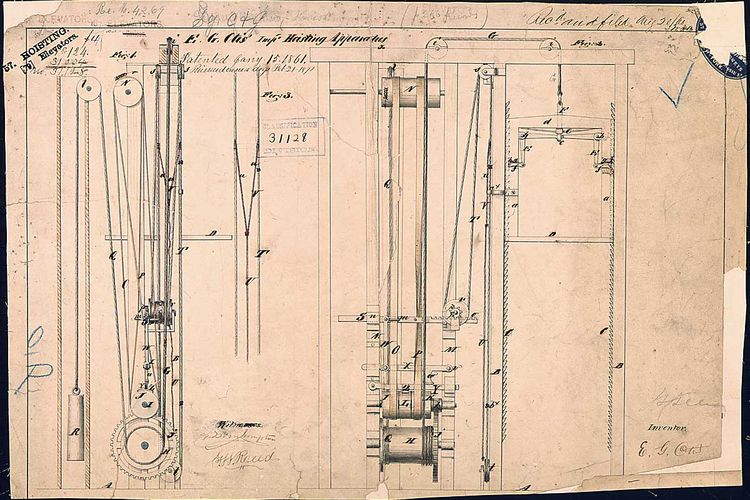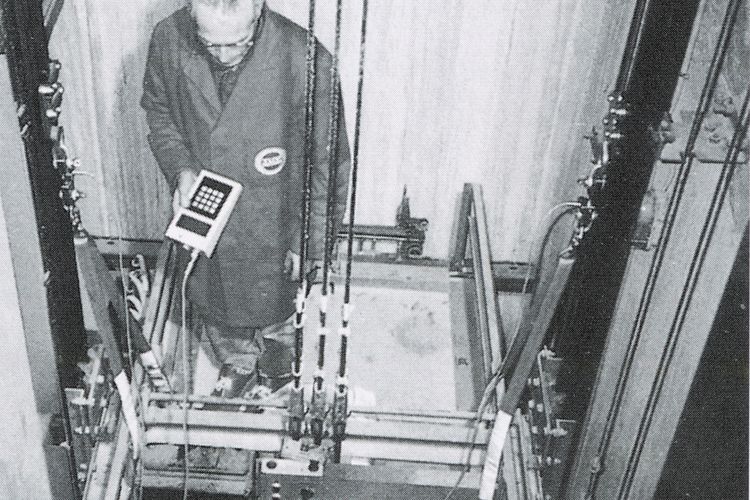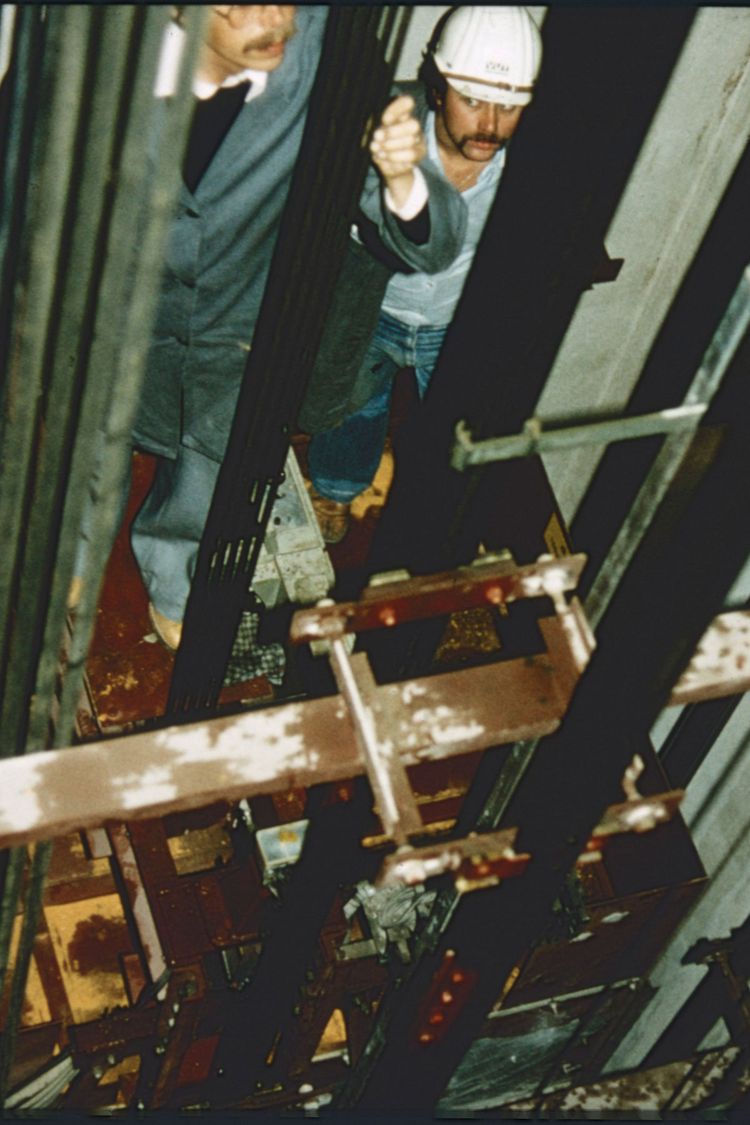08 October 2020
The most used means of transport in the world basically goes up and down: Statistically peaking, the whole of humanity uses a lift – known in America as an elevator - once every three days. How the technology has evolved over the centuries and how the lift has changed the face of our major cities is related in our brief history of the lift.
The lift in the Shanghai Tower catapults its passengers up 121 floors at 18 metres per second – almost 65 kilometres per hour. It reaches the observation deck, at an altitude of 546 metres, in a mere 55 seconds. If a technician from the manufacturer Mitsubishi is on board, it will go even faster, at almost 74 km/h. This speed record makes the lift in the world's third-highest skyscraper the fastest on our globe. A total of114 lifts are installed in the Shanghai Tower. It was the development of this purely vertical means of transport that made the construction of high-rise buildings and skyscrapers possible from the late 19th century onwards. The technical foundations for the lift were, however, laid back in the ancient world.
The lift would have been impossible without the invention of the pulley. The combination of a rope with several rollers makes it possible to lift loads with little force. The precise identity of its inventor is not recorded, but the concept of the composite pulley is attributed to Greek mathematician and physicist Archimedes. The specific use for the pulley system in ancient Rome was to hoist bears and lions up into the arena. From 80 BCE, the first of several lifts was installed in the Colosseum, which were used, among other things, to raise up backdrops and decorations.
© gemeinfreiIn 1861 Elisha Graves Otis files a patent application for his invention.
From cargo lift to “flying chair”
Of course, the early lifts were not only used to provide special effects for entertainment. It would have been impossible to build the cathedrals of the Middle Ages, for example, without cargo lifts operated by humans or animals. Until the 20th century, many of the Metéora monasteries built on sandstone cliffs in Greece could only be reached by rope ladders and nets which were pulled up by winches. For King Louis XV, it was all about ease of access when he had one of the first historically attested passenger lifts installed for his mistress in Versailles in 1743. With this “flying chair”, Madame de Chateauroux was able to access her rooms on the third floor without the inconvenience of climbing stairs. This noble passenger would operate the lift by pulling a cord attached to a pulley with counterweights. Half a century later, in 1793, the first worm-gear lift was built by Ivan Kulibin and installed in the Russian Tsar's Winter Palace in St. Petersburg.
The invention of the steam engine in the late 18th century then gave the lift an enormous boost in performance. Thanks to the steam engine, heavier loads could be transported over longer distances. Steam-powered lifts then found their way into mines. From the early 19th century, the first hydraulic lifts were installed in factories. Although they were comparatively safe on their hydraulic pistons, they were only capable of short climbs at a slow pace. Technically speaking, on the other hand, cable lifts boasted a lot more power, but the risk of cable breakage was considerable. Reliable safety systems did not yet exist, which meant that passenger lifts were rare. One notable exception was the “Floating Room” in London. This was a tourist attraction which offered paying passengers a panoramic view of the city on the Thames. A significant role in the popularisation of vertical passenger transportation was played by American mechanic Elisha Graves Otis.
„All safe, gentlemen“
In 1853 or 1854 — the historical sources disagree here — Otis clambered onto an open elevator platform at the Exhibition of the Industry of All Nations in New York. The audience in the Crystal Palace watched as the construction was winched inch by inch into the air. Then Otis gave his assistant a signal to sever the cable. The crowd held its breath — and the elevator fell. After a few inches, however, the platform came to a halt in mid-air. “All safe, gentlemen,” Otis exclaimed to the stunned audience below.
© dpaElevator model “Twin” by Thyssen-Krupp.
How does the master mechanic’s safety brake actually do what the name promises? The load-bearing cable of this Otis elevator is attached to a hard steel spring with bolts at the end. This spring is stretched by the weight of the cabin. If the cable breaks, the spring relaxes, and the bolts are propelled outwards, locking themselves into the guide rails of the cabin and bringing it to a halt.
Doors close automatically
After its successful outing at the world’s fair, the mechanic continued to work on the elevator in his Otis Elevator Company, founded in 1853. On 23 March 1857, the world's first passenger elevator with fall protection was put into operation in the Haughwout department store in New York. Otis’ elevator is operated by a steam engine and is still in use, travelling at a sedate 0.2 metres per second. The following year, the first hydraulic elevator was brought into service in a building on Broadway. For the first time, a more modern fall protection device was used, which triggered a delayed braking effect to ensure that the passengers would not be subjected to the shock of a sudden stop if the cable were to break.
It was in Mannheim In 1880 that Werner von Siemens presented the first electric lift. The inventor Alexander Miles developed a mechanism for the automatic closure of the lift doors in 1887 and registered his invention for patent in the same year.
Thanks to further developments in gearbox technology, lifts were getting faster and faster and, in combination with the steel skeleton construction, made it possible to carry out construction work at ever greater heights.
© TÜV NORDThe fist electric elevator presented by Siemens at a Commercial Fair in Mannheim in 1880.
From the bel étage to the penthouse
While the price of land was exploding at ground level in the ever more crowded metropolises, the sky above them seemed to present an infinite opportunity for expansion. With the discovery of vertical transportation, the social structure of buildings was also turned upside down. Whereas the bel étage for the city nobility and the bourgeoisie had previously been close to street level on the first floor, the rich and powerful were now being drawn up into the sky. Thanks to the lift, you no longer had to pay for a panoramic view of the city with the arduous ascent of dozens of flights of stairs. In the skyscraper, the attic rooms where the servants had once lived evolved into the exclusive penthouse. The world's highest currently sits at the top of the 426-metre-high 432 Park Avenue apartment tower in Manhattan. In 2016, it was acquired by a billionaire from Saudi Arabia for 88 million dollars.
The global race for the world's tallest building is also leading to the construction of ever faster lifts with ever longer tracks. The highest lift in Europe has been ferrying visitors 337 metres up to the observation deck in Moscow’s Ostankino TV tower since the late 1960s. The highest open-air lift on our continent has been in operation for 115 years in the Swiss mountains near Lucerne. Since 1905, the Hammetschwand lift has carried passengers 118 metres to the lookout point of the same name over Lake Lucerne. The wooden cabin with its zinc cladding once used to take about three minutes for the journey. With the glazed panoramic cabin installed in 1992, you are now whisked up to the disembarkation point in just one minute.
There’s no safer way to travel
In Germany alone, according to the estimates of the Association of TÜV Companies (VdTÜV), 700,000 lift systems are in use today, most of them passenger lifts. Every year, the Association of German Machinery and Plant Engineering (VDMA) says, an average of 20,000 new lifts is added to the total or installed to replace older systems. Thanks to regular TÜV tests, accidents are incredibly rare. It’s for this reason that lifts are commonly considered the safest means of transportation in the world. According to the VDMA, no deaths related to lifts were recorded in 2017. The industry association reports that the seven serious accidents recorded occurred exclusively during maintenance work, and only four of them were due to a defect in a lift.
© TÜV NORDElevator testing has a long history at TÜV NORD.
© TÜV NORDTÜV Hannover at work in the 80’s.
In addition to the speed of travel, lift technology is also advancing on other levels. For example, the cabins have become more autonomous over time. In 2003, Thyssen-Krupp developed the Twin, in which two cabins travel independently on their own cables in the same shaft. This allows more passengers to be carried in a shorter time than with a conventional lift. The master computer uses a destination selection control system to know where each trip should begin and end, thus avoiding the risk of collisions. In Germany, for example, the system is in use in the Sky Office in Düsseldorf and the 200-metre-high Skytower of the European Central Bank in Frankfurt am Main.
Lifts unleashed
If Thyssen-Krupp has its way, the lift of the future will even get rid of its cables. In Rottweil, Baden-Württemberg, the company is testing the “Multi”. Based on the technology of the Transrapid, this lift uses a magnetic field. Just like the magnetic levitation train, the cabin swishes up and down on a four-millimetre-thick magnetic cushion – and can also move sideways. At set points, the cabins change their direction of travel from the vertical to the horizontal. This is because the system has two shafts: In one, the cabins go upwards; in the other, down. In this way, any number of cabins should be able to circulate independently of each other in a lift shaft and even overtake each other.
© thyssenkruppThyssen-Krupp’s testing facility in Rottweil.
Dispensing with the cable should also eliminate the problem of the height restriction. A conventional lift can’t scale a height of much more than 500 metres, at least with a classic steel cable, because the cables then get too heavy and oscillate too much from side to side. This presents no problem for the Multi at all, allowing it to carry more passengers in less time with lower energy costs. It is true that such a system is three to five times more expensive than a classic lift, but because the technology requires fewer and smaller shafts, it should free up to 25 percent more space for offices or apartments. And, at the same time, it should pave the way to completely new construction methods.
The first Multi is planned for the East Side Tower in Berlin. This 140-metre office tower is being built not far from the Eastside Gallery in the Friedrichshain district and is expected to be ready for occupancy by 2023. From then on, the world's most commonly used means of transport may also be able to conquer the horizontal dimension.
You may also like
Elevator? Flying chair? Lift!
Anyone who tries to tell a lift technician that the “Fahrstuhl” (“flying chair”) is broken may well be met by a frown of incomprehension. It is true that, in German, the Duden dictionary considers the terms “Aufzug” and “Fahrstuhl” to be synonymous. However, in the technical literature and in the corresponding DIN standards, only the word “Aufzug” (“lift”) is mentioned.
The word “Lift" is actually more readily associated in the German-speaking world with those lifts that rise obliquely rather than vertically into the air – from ski lifts to chair and stair lifts.
The term “Fahrstuhl” probably derives from the “flying chair” – early passenger lifts, a type of which, for example, the Empress Maria Theresa would use to spare herself the inconvenience of having to climb stairs. Since today's lifts don’t normally have seats and generally haul their load vertically upwards, “Fahrstuhl” is regarded by experts as an improper designation for a lift.








